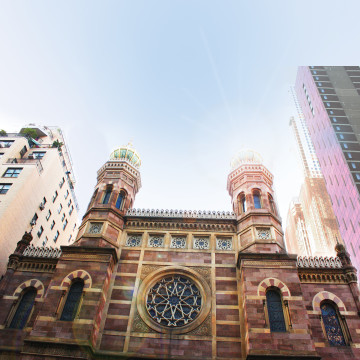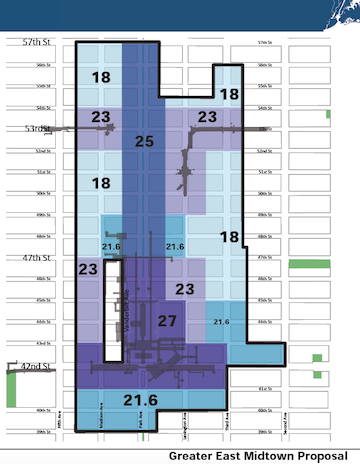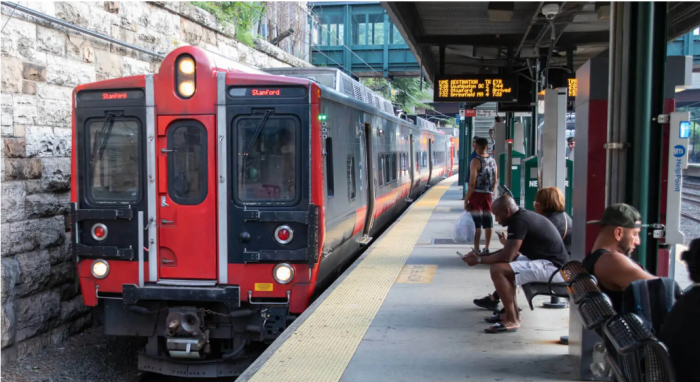
BY JACKSON CHEN | The Department of City Planning certified the proposed Midtown East rezoning on January 3, moving the initiative aimed at reinvigorating the area with modern office building construction into the public review phase. The first step of that review allows Community Boards 5 and 6 to weigh in with resolutions, expected in two months’ time.
The Midtown East rezoning proposal is designed to attract state-of-the-art office building construction by offering developers incentives to build with greater floor-to-area ratios (FARs, which compare total floor space to the size of the land on which a building sits ) than otherwise allowable so long as they secure the development rights from landmarked buildings or contribute to a public realm improvement project nearby. The rezoning would affect the area roughly from East 39th to 57th Streets, between Third and Fifth Avenues, extending east to Second Avenue between East 42nd and 43rd Streets.
The proposal sets out guidelines for landmarked buildings, barred from maximizing their development potential, to sell their unused development rights in order to facilitate the upkeep of their property. A portion of those sale proceeds would be earmarked for a public benefits fund controlled by the city to make quality of life improvements to nearby transit infrastructure or public open space.
“This rezoning will not only facilitate development of the type of quality office towers that will attract a range of employers to East Midtown, but it also will produce 21st century transit and pedestrian upgrades,” Carl Weisbrod, the City Planning Commission’s chair, said in a press release. “The Greater East Midtown area is the city’s premier business district. It generates approximately 10 percent of the city’s entire real estate taxes so it is essential that it continues to maintain its status as a world class economic magnet.”
Having completed the certification of the Midtown East rezoning, Weisbrod, who has worked in public urban planning management for more than 40 years, announced he was stepping down from his dual role as head of the City Planning Department and the Planning Commission. A former Weisbrod staffer, Marisa Lago, who now works for the US Treasury Department, will take his place, Mayor Bill de Blasio announced.
Prior to the certification, on December 30, the DCP released its newest iteration of the proposal, which the community boards are now working through meticulously before they come to any votes.
On January 4, a day after the certification, Community Board 6’s Land Use and Waterfront Committee met and held an informal discussion on the rezoning proposal. While some board members hadn’t yet been able to comb through the 78-page document, others offered initial thoughts.

CB6’s Terrence O’Neal said he remains disappointed there is not enough mention of public space in the document and still hopes to see more of a bonus offered to developers who create privately owned public spaces, or POPS. The community board’s chair, Richard Eggers, said there would be two opportunities to weigh in – at the February and March CB6 meetings – but that final action was expected by the second of those two.
CB5 will also be considering the proposal, at its February 1 Land Use Committee meeting and in the March full board meeting, at which time a vote will be taken.
The most significant bit of news in the rezoning’s most recent draft is that the levy on development rights sales for the Public Realm Improvement Fund will be 20 percent. The projects financed from that fund will be at the discretion of a nine-member Governing Group.
With preliminary discussion of that levy ranging between 20 and 40 percent, owners of landmarked properties seemed pleased that the city had settled on the low end of that range.
“We applaud the city taking necessary action to rezone this stretch of Manhattan, ensuring it remains an economic catalyst for the entire city for decades to come,” a spokesperson for St. Patrick’s Cathedral said. “During this next phase of the public review, we urge our local representatives to deliver a final plan that meets the twin objectives of promoting development and adequately funding historic preservation.”
The Landmarks Preservation Commission recently designated 12 new sites within the proposed rezoning area as landmarks, adding them to a roster that includes well-known institutions including St. Patrick’s on Fifth Avenue, St. Bartholomew’s Episcopal Church on Park Avenue, and the Central Synagogue on Lexington Avenue.
Both CB5 and CB6 are expected to submit their final resolutions by March 13. After that, the proposal goes in front of Borough President Gale Brewer, the City Planning Commission, and finally the City Council, likely this coming summer.


































